How to Expertly Brine a Turkey, According to Chefs
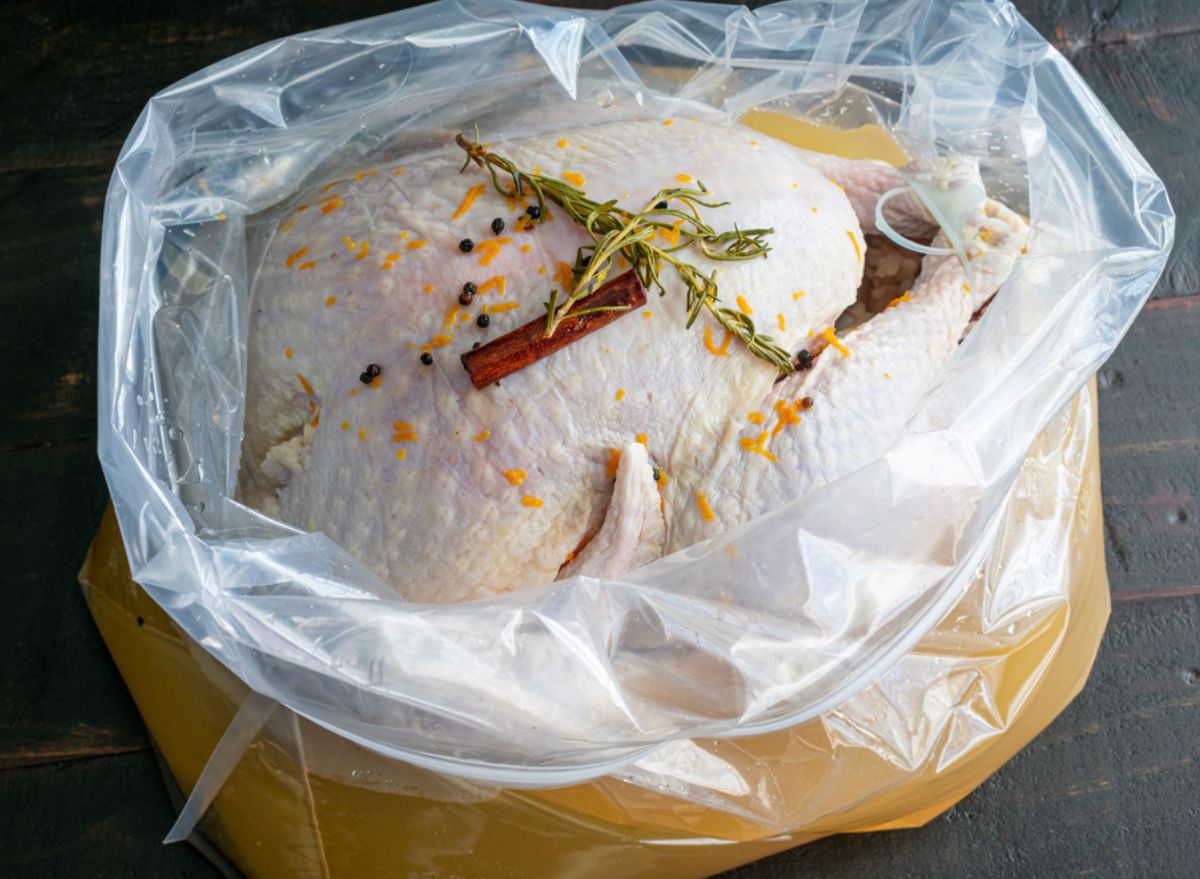
Deciding to prepare a turkey for Thanksgiving is quite the undertaking. Cooking this traditional holiday poultry comes with a handful of potential difficulties, like finding the right size turkey for your group, adding enough flavor, leaving enough time to thaw, and avoiding one of the most common turkey-related issues: making sure it doesn’t dry out. One way to avoid a dry turkey is by brining it, but exactly how do you brine a turkey the right way?
Brining involves submerging the turkey in a saltwater solution, which not only seasons the meat from the inside out but also changes its protein structure. This allows the meat to retain more moisture during cooking, resulting in a juicier and more flavorful turkey. Unlike simply salting the surface, which only reaches the outer layers, brining distributes seasoning and moisture throughout the bird. While this extra step isn’t required, it can transform any turkey from mediocre to mind-blowing.
If you’re brining for the first time or preparing a feast for a crowd, the process can feel a bit intimidating. That’s why we consulted expert chefs to share their top tips. Read on to learn how to brine your Thanksgiving turkey like a pro, and for more dinner inspiration, check out 25 Best-Ever Thanksgiving Recipes.
Thaw the turkey.
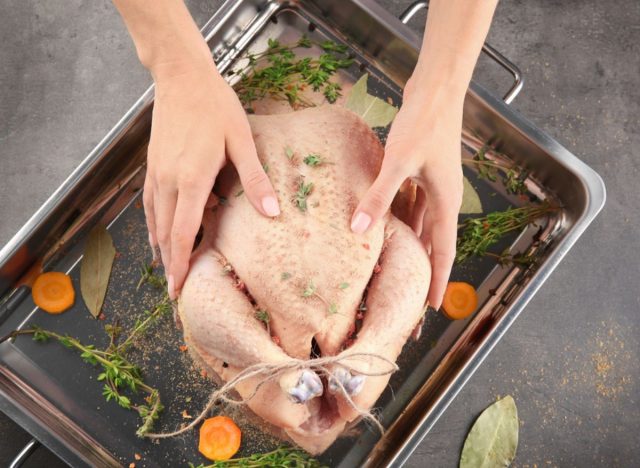
One common mistake that people make when preparing their Thanksgiving turkey is that they don’t realize how long it takes for a frozen turkey to thaw.
According to Chef Chris Nirschel with NY Catering Service, you need to make sure your turkey is fully thawed before you begin to brine it, “Which can take several days in the refrigerator, so plan accordingly.”
The USDA says a general rule of thumb when thawing your turkey in the refrigerator is about 24 hours for every 4-5 pounds of bird. For larger turkeys around 20 pounds, you’re potentially looking at somewhere around 5 days of thawing!
Find the right container for a large volume of brine.
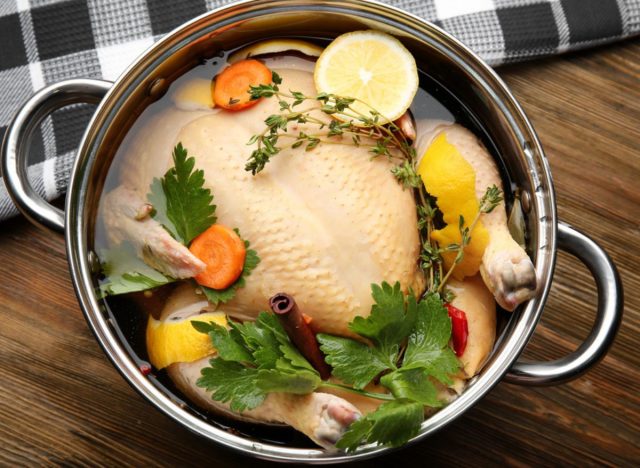
A major component to consider when you’re getting ready to brine your turkey is making sure you have the right container for it. Because the brining process takes a bit of time, you’ll need a container that is not only big enough for your turkey but small enough to fit into your refrigerator.
Your turkey should be completely covered with the brine solution, says Michael Handal, chef-instructor at the Institute of Culinary Education, so you’ll either need a 10-quart pot with tall sides, or a brining bag if a large pot won’t fit in your fridge.
“You’ll want to make sure whatever you brine your turkey in can fit back into your fridge, as well as make sure your container doesn’t react with your brine solution and leave an off-flavor,” says Heidi Diestel, 4th Generation Farmer at Diestel Family Ranch.
To accomplish this, Chef Thomas Ricci, VP of Culinary Operations at Gobble & Sunbasket says “You can use a turkey bag, or [if you’re using a dry brine,] a large plate loosely tented with aluminum foil before letting [the turkey] rest in the refrigerator for 36-48 hours before cooking.”
How to make a brine.
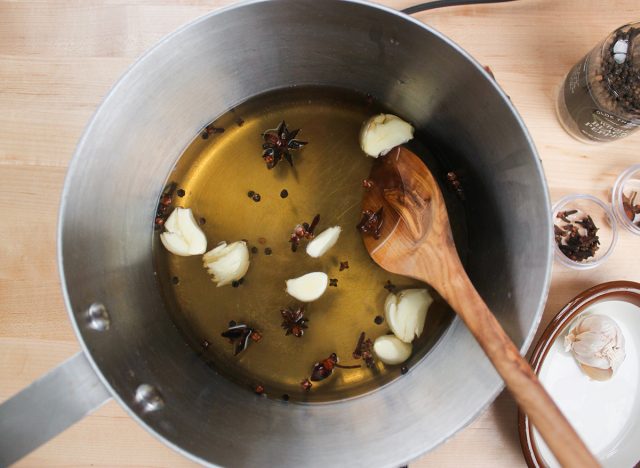
A brine is a fairly straightforward cooking technique. All you have to technically do is create a saltwater solution with 1 cup of salt for every gallon of water you use.
While a basic brine solution consists of just salt and water, chefs strongly recommend adding some other elements to amp up the flavor. “Aromatic molecules do get lodged within the turkey tissue between cells, so the more intense the flavorings in your brine, the more those flavors will potentially be imparted to the meat,” says Erin Miller, executive chef and owner of Urban Hearth.
Basic Brine Recipe
Courtesy of Chef Eric Caron, corporate executive chef for Lombardo’s Hospitality Group
- 7 quarts of water
- 1.5 cups of kosher salt
- 0.25 cups of sugar
- Additional seasonings: citrus fruits, carrots, celery, ginger, garlic, sage, rosemary, fennel, coriander, juniper, five-spice blend, and dried chilis.
Mix all ingredients in a large container until the salt and sugar are dissolved, then let rest for 24-48 hours. “If your recipe calls for the salt and sugar to be dissolved by heating the brine, make sure the brine has been cooled completely before adding the turkey,” Chef Handal adds.
Buttermilk Brine Recipe
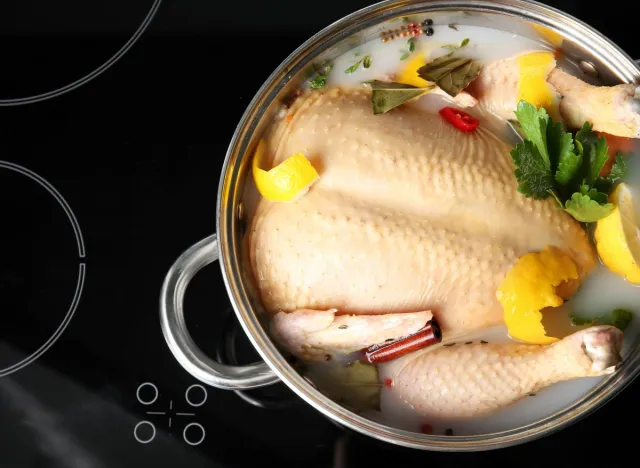
Courtesy of Chef Chris Nirschel with NY Catering Service
- 1 whole turkey (12-14 pounds)
- 2 gallons of buttermilk
- 1 cup kosher salt
- 1/2 cup brown sugar
- 1 tbsp black pepper
- 1 tbsp dried thyme
- 1 tbsp garlic powder
- 1 tbsp onion powder
- 1 tbsp paprika
- 1 tsp cayenne pepper (adjust to taste)
- 1 large onion, quartered
- 1 lemon, halved
- 4 sprigs of fresh rosemary
- 4 sprigs of fresh thyme
- 4 cloves of garlic, smashed
A basic brining solution consists of water, salt, and herbs, but Chef Chris Nirschel suggests turning it up a notch and using a buttermilk brine. “I like to use a buttermilk brine,” he says. “Even though it is not as conventional, it is very effective.”
To make the buttermilk brine, Chef Nirschel says “In a large mixing bowl, combine buttermilk, kosher salt, brown sugar, black pepper, dried thyme, garlic powder, onion powder, paprika, and cayenne pepper. Then stir the mixture until the salt and sugar are completely dissolved.”
Dry Brine Recipe
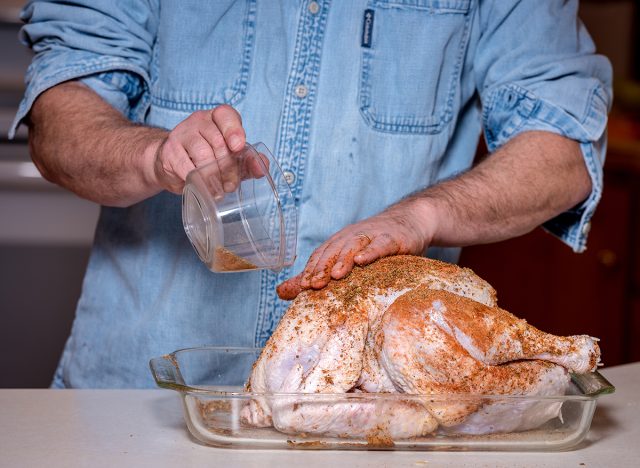
If you’re smoking your turkey, or are just looking for a no mess, no fuss alternative, you may want to consider dry brining, says Chef Thomas Boemer of Revival.
Boemer suggests using your favorite BBQ rub, or if you’re roasting the bird, try a combo of kosher salt, granulated garlic, onion powder, black pepper, thyme, sage, and paprika.
“Make sure your turkey is thawed out completely and patted dry so there is no excess moisture,” says Boemer. “Season all surfaces, including the inside of the cavity, the morning before roasting. Leave the turkey uncovered in the fridge overnight, which will slightly dry the skin to produce a crispy and golden brown exterior, and then roast as typical.”
Consider separating the bird into parts.
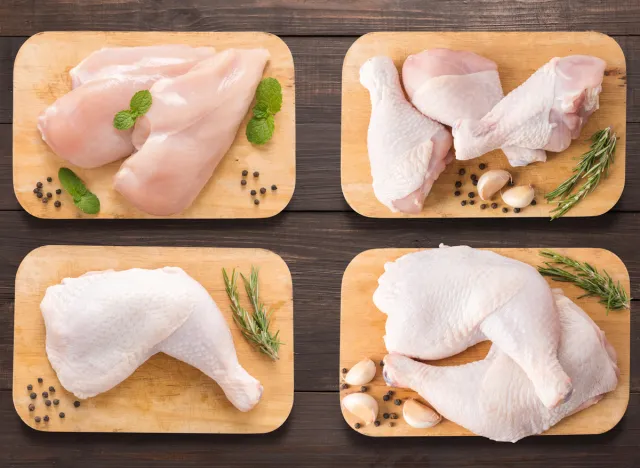
“Turkey breast and turkey leg quarters might as well be from different animals when it comes to cooking technique,” says Erin Miller, executive chef and owner of Urban Hearth. “The fact that we try to cook them together using the same techniques really mystifies me. The outcome is rarely good.”
While turkey breast brines up nicely because it’s lean, the leg quarters need less brining since there’s more fat and connective tissue, according to Miller. In fact, she says brining the legs may actually dilute the flavor. Instead, she advises seasoning them with a heavily salted marinade or dry rub.
“After brining the breast, I generally butterfly it, apply a dry spice rub, retie it into a roulade, roast it in the oven, and then reunite it with the leg at the table,” adds Miller.
Be mindful of the type of salt you use.
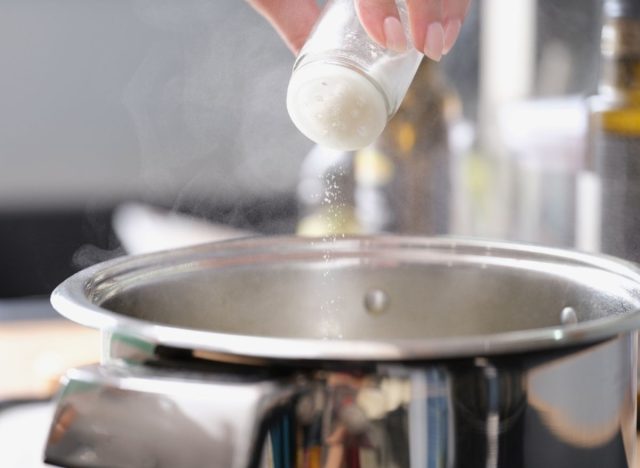
Salt is salt, right? Not exactly. According to Handal, it’s crucial to use whatever specific type of salt is listed on your chosen brining recipe.
Kosher salt and sea salt have a coarser grain than table salt. And because of the different-sized granules, the amount of salt in one tablespoon or cup can vary. This means you can’t substitute one for the other without adjusting the amounts. Not only that but what further distinguishes kosher salt from table salt is that it has no iodine, which affects the flavor.
“Table salt and Kosher salt differ in densities and can have drastically different results,” Handal explains.
Plan to brine at least 12 hours.
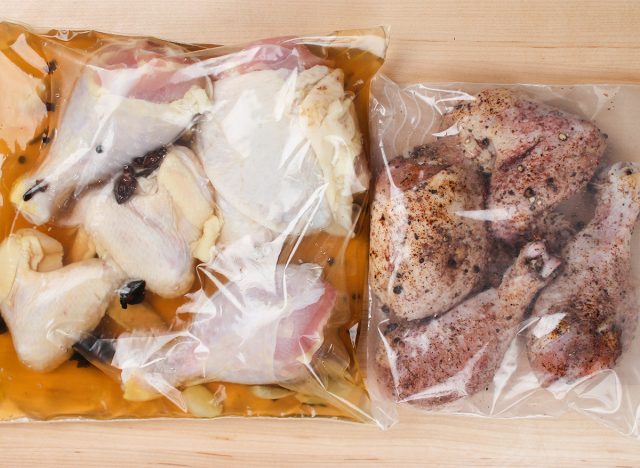
“When you want seasoned meat all the way to the bone, time is your best friend,” says Brian Jupiter, executive chef at Chicago’s Frontier and Ina Mae Tavern. And ideally, Jupiter recommends brining your turkey for 24-48 hours.
According to Handal, you’ll want to aim for a minimum brining time of 12 hours. But don’t go beyond 48 hours, he says, or you’ll risk spoilage.
“If you choose the 48-hour method, reduce the amount of salt you put in your brine by 25% so that your turkey is not over-seasoned,” Jupiter adds.
Don’t brine a ‘pre-brined’ turkey.
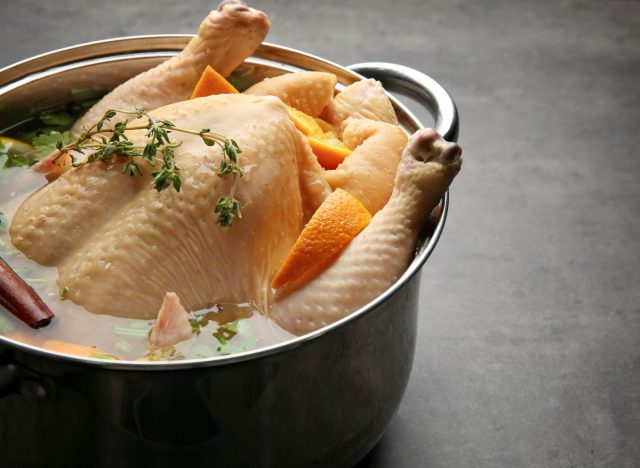
Many people don’t realize that when you buy a turkey from the store, it sometimes comes pre-brined, meaning it’s been injected with a brining solution before being sold.
“Most commodity turkeys are already injected with salt and water, so you don’t want to brine that bird,” says Diestel.
Turkey that has been pre-brined will be labeled as “kosher,” “basted,” or “self-basted,” so look out for these keywords when you’re shopping for your Thanksgiving turkey.









